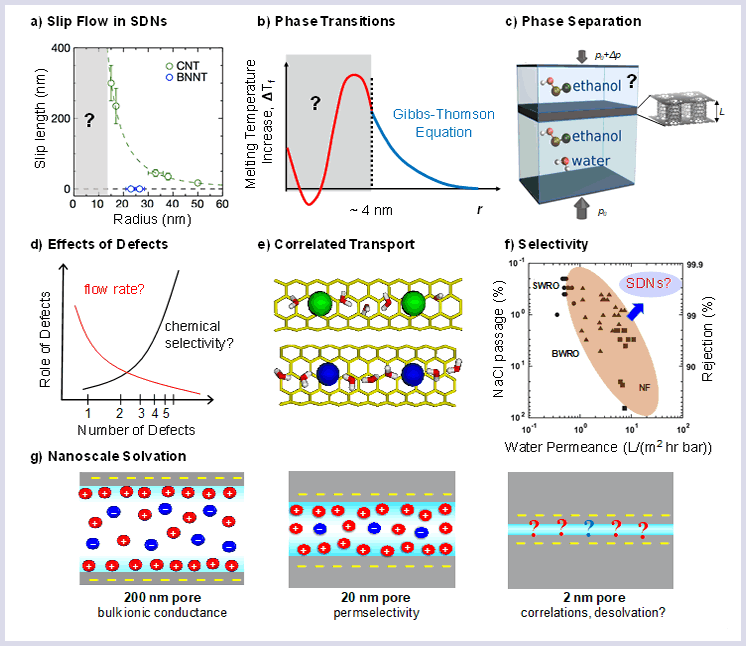Knowledge Gaps
CENT is focused on a series of fundamental scientific questions addressing the knowledge gaps (KGs):
KG1: Slip Flow Enhancement in SDNs is Unexpectedly Enormous
Several recent studies suggest that paradoxically the narrowest pores, indeed SDNs, demonstrate the largest slip length enhancements. Mechanistic understanding of this scaling is in its infancy as theory and simulations have failed to predict recent measurements on larger nanopores. However, SDNs demonstrating this flux enhancement will inspire a new generation of high flux, high selectivity membrane technology. Indeed, one of the key knowledge gaps identified in the 2018 BES Report for Basic Research Needs for Energy and Water states that “a good understanding is lacking of the synergistic effects of confinement and the interactions among water, solutes, and materials through which permeation occurs.”
KG2: Fluid Phase Transitions in SDNs Deviate Significantly from Bulk Fluids
Confined fluids in nanopores exhibit significant distortions of the unconfined phase boundary. These distorted phase transitions are well understood for pores larger than approximately 4 nm through the use of the Turnbull coefficient and the Gibbs Thomson equation. However, no theory currently exists for describing the narrowest of pores represented by SDN. Below approximately 4 nm, the Gibbs Thomson equation fails significantly, with freezing points elevating or depressing dramatically, and varying nonmonotonically with pore diameter.
KG3: Phase-Separation under Confinement for Novel Separation Mechanisms
Phase separation, where a single phase transitions into the two- or multi- phase co-existence region, is also distorted under the extreme confinement of SDNs. Of particular interest is the use of this phenomenon to discover new nanopore and membrane separation mechanisms. Very little is known about the behavior of non-aqueous fluids under similar conditions of extreme nano-confinement, as in SDNs. We anticipate and seek to theoretically describe spontaneous ordering of the solvent, precipitation, and phase separation. A related question is whether and how the confinement in a small nanopore changes the thermodynamics and kinetics of phase separation of ordinarily miscible fluids.
KG4: Defects Impose an Outsized Impact on SDN Transport
The 2018 BES Report for Basic Research Needs for Energy and Water states that “there is a knowledge gap at how physical and chemical heterogeneities affect transport and interfacial interactions.” Unlike the larger pores, where the fluid can easily flow around a defect site, enhanced confinement in SDNs could amplify the effects of a defect or a feature in the structure of the fluid conduit. An intriguing hypothesis is that in extreme cases fluid interactions with defects in SDNs and the resulting pinning effects could completely change the nature of the transport through the pore. Remarkably, except a few recent studies, these effects remain completely unexplored.
KG5: Correlated Transport of Ions can Result from Confinement in SDNs
Strong nanopore confinement, which is often accompanied by partial or complete solute desolvation, can also give rise to interesting physical phenomena where the ions and molecules exhibit unusual spatial and temporal correlation. Partial removal of ion solvation shells, which prevents those ions from forming long-term pairs in the bulk, could lead to unusually long-lived ion pairs and even larger aggregates, and potentially enhanced reaction dynamics. Spontaneous long-scale ordering in nanopores could also create conditions for efficient and selective transport of particular species. Enhancements in the scaling of flux and selectivity for SDNs point to operating regions for nanopore systems (i.e., membranes) that break flux-selectivity tradeoffs.
KG6: SDNs can Exploit Nanoscale Solvation for New Separation Mechanisms
As confinement approaches the levels seen in SDN channels, solvation effects start to diverge from their bulk pattern with profound effects on transport efficiency and selectivity. We need to understand the energetics of solvation under strong confinement and determine how these effects change energy barriers for nanopore entry and the double-layer effects inside the pore. Understanding and exploiting these phenomena in synthetic SDNs could produce a new generation of membranes that are capable of manipulating hydration effects to achieve single-species selectivity in a manner that is virtually impossible to achieve with current technologies.
KG7: SDNs can Exploit Charge Exclusion to Significantly Enhance Selectivity
Membrane-based technologies have been identified in the BES Report for Basic Research Needs for Energy and Water as one of the most important energy-water issues. To date, synthetic, single-species selective membranes (transporting e.g., K+ but not Na+) do not exist. Systematically studying steric- and charge exclusion mechanisms, as well as incorporating interpore chemistry and controlled reaction sites in SDNs will facilitate the improvement of the selectivity of state-of-the-art membrane and provide design principles for new multipore selective systems.

Critical knowledge gaps in SDN nanofluidics. (a) The scaling of slip length with nanopore diameter is unknown in the single-digit range. (b) The phase behavior of fluids inside SDNs cannot be predicted with existing theories. (c) Phase separation may be enhanced by nanoconfinement. (d) Defects may have an outsized effect on transport inside single-digit nanopores, but the magnitude of these effects is unknown. (e) Transport of ions in single-digit nanopores shows novel spatial and temporal correlations. (f) SDNs may form the basis for systems with enhanced molecular and ionic selectivity. (g) Solvation in confinement differs from that in bulk, with profound effects on transport rates and selectivity.
More can be found in our recent paper: “Critical Knowledge Gaps in Mass Transport through Single-Digit Nanopores: A Review and Perspective” by S. Faucher et al. in J. Phys. Chem. C (2019).
